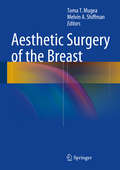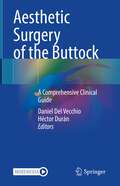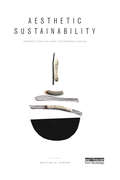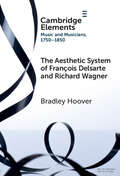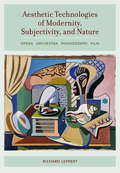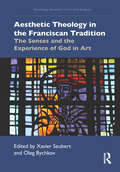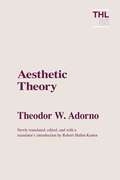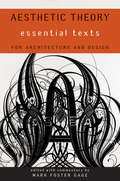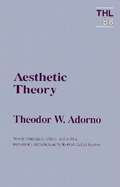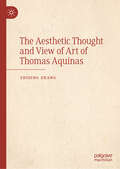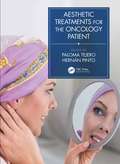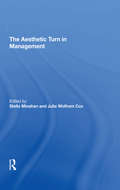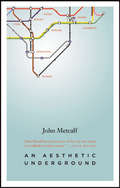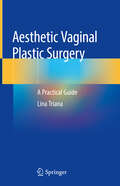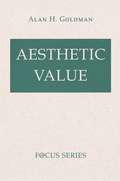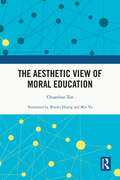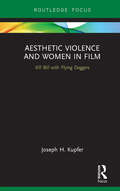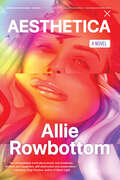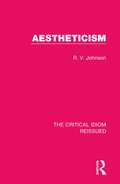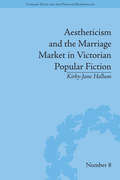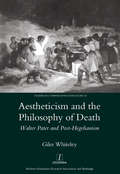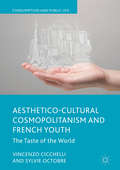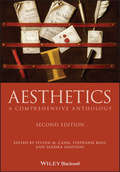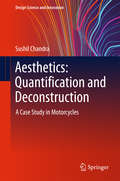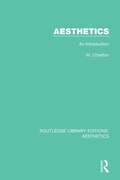- Table View
- List View
Aesthetic Surgery of the Breast
by Melvin A. Shiffman Toma T. MugeaThis book covers all aspects of aesthetic breast surgery in an instructive, step-by-step format. The descriptions of procedures are completely up to date, encompassing newly introduced techniques and recent modifications of established techniques. Individual parts of the book are devoted to breast augmentation, mastopexy, and breast reduction. Detailed consideration is also given to risks and complications, with guidance on their avoidance and the treatment of complications. In addition, anatomy, anesthesia, and a range of miscellaneous procedures applicable in specific circumstances are all well covered The authors are acknowledged experts in their fields who draw on a wealth of experience in describing and illustrating their personally favored techniques. Aesthetic Surgery of the Breast will be an ideal reference for both students (residents and fellows) and practicing cosmetic, plastic, and general surgeons.
Aesthetic Surgery of the Buttock: A Comprehensive Clinical Guide
by Daniel Del Vecchio Héctor DuránIn the past five years, buttock surgery has been changing and expanding worldwide, while also attracting media attention. Surgeons have been confronted with a shocking number of requests for buttock augmentation surgeries. Further, as patients become more complex, more complex procedures are called for, such as fat infiltration surgery combined with implants or, for example, modifying the waist-to-hip ratio.Aesthetic Surgery of the Buttock is the first book of its kind, covering all relevant aesthetic issues. It offers essential guidance on performing surgery, but also on avoiding complications due to fat infiltration in large blood vessels and thus avoiding embolisms at the pulmonary level. In addition, much of the book addresses various aspects of fat infiltration, e.g. obtaining, processing and applying this fat. It also discusses implants, which are an excellent option for many patients, as well as new trends in the combination of fat infiltration and implants to achieve more natural results. Given its scope, it represents an invaluable asset for all plastic surgeons around the globe who perform body-contouring surgeries.
Aesthetic Sustainability: Product Design and Sustainable Usage (Routledge Studies in Sustainability)
by Kristine H. HarperWhy do we readily dispose of some things, whereas we keep and maintain others for years, despite their obvious wear and tear? Can a greater understanding of aesthetic value lead to a more strategic and sustainable approach to product design? Aesthetic Sustainability: Product Design and Sustainable Usage offers guidelines for ways to reduce, rethink, and reform consumption. Its focus on aesthetics adds a new dimension to the creation, as well as the consumption, of sustainable products. The chapters offer innovative ways of working with expressional durability in the design process. Aesthetic Sustainability: Product Design and Sustainable Usage is related to emotional durability in the sense that the focus is on the psychological and sensuous bond between subject and object. But the subject–object connection is based on more than emotions: aesthetically sustainable objects continuously add nourishment to human life. This book explores the difference between sentimental value and aesthetic value, and it offers suggestions for operational approaches that can be implemented in the design process to increase aesthetic sustainability. This book also offers a thorough presentation of aesthetics, focusing on the correlation between the philosophical approach to the aesthetic experience and the durable design experience. The book is of interest to students and scholars working in the fields of design, arts, the humanities and social sciences; additionally, it will speak to designers and other professionals with an interest in sustainability and aesthetic value.
The Aesthetic System of François Delsarte and Richard Wagner: Catholicism, Romanticism, and Ancient Music (Elements in Music and Musicians 1750-1850)
by Bradley HooverOn 17 September 1839, Richard Wagner arrived in Paris. Although scholars agree that the composer learned a great deal about aesthetics during his first sojourn in the city, what has not been known is exactly what he learned and from whom. This Element explores the striking similarities between Wagner's early aesthetic writings and François Delsarte's 'Cours d'esthétique appliquée', a theoretical and practical training course for artists which Delsarte began teaching in Paris in May 1839. This Element also details the rise of Delsarte as a celebrated teacher of aesthetics and interpreter of Gluck's repertoire during the same years that Wagner lived in the city. By comparing historical timelines, published documents, and manuscript sources and by analysing Wagner's treatises, Das Kunstwerk der Zukunft and Oper und Drama, and the essay 'Über Schauspieler und Sänger', the author shows that Delsarte's course is the most likely source of Wagner's aesthetic transformation in Paris.
Aesthetic Technologies of Modernity, Subjectivity, and Nature: Opera, Orchestra, Phonograph, Film
by Richard LeppertVirginia Woolf famously claimed that, around December 1910, human character changed. Aesthetic Technologies addresses how music (especially opera), the phonograph, and film served as cultural agents facilitating the many extraordinary social, artistic, and cultural shifts that characterized the new century and much of what followed long thereafter, even to the present. Three tropes are central: the tensions and traumas--cultural, social, and personal--associated with modernity; changes in human subjectivity and its engagement and representation in music and film; and the more general societal impact of modern media, sound recording (the development of the phonograph in particular), and the critical role played by early-century opera recording. A principal focus of the book is the conflicted relationship in Western modernity to nature, particularly as nature is perceived in opposition to culture and articulated through music, film, and sound as agents of fundamental, sometimes shocking transformation. The book considers the sound/vision world of modernity filtered through the lens of aesthetic modernism and rapid technological change, and the impact of both, experienced with the prescient sense that there could be no turning back.
Aesthetic Theology in the Franciscan Tradition: The Senses and the Experience of God in Art (Routledge Research in Art and Religion)
by Xavier Seubert Oleg BychkovThe book investigates the aesthetic theology embedded in the Franciscan artistic tradition. The novelty of the approach is in applying concepts gleaned from Franciscan textual sources to create a deeper understanding of how art in all its sensual forms was foundational to the Franciscan milieu. Chapters range from studies of statements about aesthetics and the arts in theological textual sources to examples of visual, auditory, and tactile arts communicating theological ideas found in texts. The essays cover not only European art and textual sources, but also Franciscan influences in the Americas found in both texts and artifacts.
Aesthetic Theory: Construction Of The Aesthetic (Theory and History of Literature #88)
by Theodor W. AdornoPerhaps the most important aesthetics of the twentieth century appears here newly translated, in English that is for the first time faithful to the intricately demanding language of the original German.The culmination of a lifetime of aesthetic investigation, Aesthetic Theory is Adorno&’s major work, a defense of modernism that is paradoxical in its defense of illusion. In it, Adorno takes up the problem of art in a day when &“it goes without saying that nothing concerning art goes without saying.&” In the course of his discussion, Adorno revisits such concepts as the sublime, the ugly, and the beautiful, demonstrating that concepts such as these are reservoirs of human experience. These experiences ultimately underlie aesthetics, for in Adorno&’s formulation &“art is the sedimented history of human misery.&”Robert Hullot-Kentor&’s translation painstakingly, yet fluently, reproduces the nuances and particularities of the original. Long awaited and significant, Aesthetic Theory is the clarifying lens through which the whole of Adorno&’s work is best viewed, providing a framework within which his other major writings cohere.
Aesthetic Theory: Essential Texts
by Mark Foster GageA collection of pivotal ideas about beauty from throughout history, with an introduction and critical headnotes. This collection of writings on beauty includes selections from twenty key philosophers and theoreticians spanning two millennia: Plato • Aristotle • Vitruvius • Alberti • Kant • Burke • Fiedler • Nietzsche • Wilde • Bergson • Bell • Scott • Benjamin • Bataille • Sontag • Jameson • Scarry • Nehamas • Zangwill • Freedberg and Gallese With an introduction and critical headnotes explaining the importance of each text, Mark Foster Gage offers a framework for a provocative history of ideas about beauty as they relate to contemporary thinking on architecture and design. In a world increasingly defined by sumptuous visuality, the concepts of beauty and visual sensation are not mere intellectual exercises but standards that define the very nature of design practice across disciplines and that are essential to the emerging worlds of design and architecture in the twenty-first century.
Aesthetic Theory
by Theodor W. AdornoPerhaps the most important aesthetics of the twentieth century appears here newly translated, in English that is for the first time faithful to the intricately demanding language of the original German. The culmination of a lifetime of aesthetic investigation, Aesthetic Theory is Theodor W. Adorno's magnum opus, the clarifying lens through which the whole of his work is best viewed, providing a framework within which his other major writings cohere. Translated by Robert Hullot-Kentor.
The Aesthetic Thought and View of Art of Thomas Aquinas
by Zhiqing ZhangThis book examines Aquinas's aesthetic thought and view of art within the broader context of medieval aesthetics and the history of aesthetic development, emphasizing its profound influence on later aesthetics. The book not only elaborates on Aquinas's efforts to establish coherence between faith and reason, the transcendent and empirical, as well as its significance, but also discusses the main contents and characteristics of Aquinas's aesthetic thought from the three aspects of the ontology of beauty, the theory of form, and the theory of experience. By examining Aquinas's aesthetic thought and view of art in relation to modern aesthetics and twentieth-century aesthetics, this book reveals the immense vitality of Aquinas's aesthetic thought.
Aesthetic Treatments for the Oncology Patient
by Paloma Tejero and Hernán PintoPhysicians are increasingly recognizing that helping a cancer patient feel good about themselves and about their appearance can be of vital importance in giving them the emotional support and psychological resilience to survive and recover from the side-effects of disease and its treatment. Dermatologists and other aesthetic physicians are in a prime position to help a cancer patient recover lost volume, hydration, and pigmentation in skin, nails, and hair, as well as to advise on nutrition, prostheses, and complentary therapies. This pioneering volume will be an important resource bringing together the expertise in this area, with the practical detail a physician will need.
The Aesthetic Turn in Management (The\international Library Of Essays On Business And Management Ser.)
by Stella MinahanOrganization students and scholars are able to trace the rise of aesthetics in management studies through the papers presented in this volume. The papers are arranged for individual review or thematic explorations of aesthetic thinking; including review papers and articles that focus on fashion, narrative, theatre, music and craft. This volume is a major contribution for those seeking alternatives to rational and positivist perspectives on management and who are willing to explore those alternatives beyond the usual disciplinary bases.
An Aesthetic Underground
by John Metcalf"John Metcalf has written some of the very best stories ever published in this country."--Alice MunroThe Argus-eyed editor; the magisterial prose stylist; the waggish, inflammatory cultural critic; the mentor and iconoclast. John Metcalf is a literary legend whose memoir maps the underground he labored tirelessly to establish.
Aesthetic Vaginal Plastic Surgery: A Practical Guide
by Lina TrianaThis book schematically discusses the available techniques for aesthetic vaginoplasty, including vagina rejuvenation and other related surgical and non-surgical approaches. By furthering our understanding of the field, it promotes a better surgical practice on aesthetic vaginal surgeries. More specifically, this book will enable surgeons to correctly assess patients, choose and plan procedures, and reproduce the most common surgical aesthetic vaginal procedures.Each chapter is written in a pedagogical way, promoting a direct applicability. For each surgical procedure discussed, it features topics such as consultation and patient’s intentions, clinical examination, anatomy and important landmarks, surgical technique and possible complications. Aesthetic Vaginal Plastic Surgery: A Practical Guide is intended for any medical professional interested in vagina aesthetic and rejuvenation procedures, especially those in the fields of plastic surgery, gynecology and urology.
Aesthetic Value (Focus Series)
by Alan GoldmanAt the heart of aesthetics lie fundamental questions about value in art and the objectivity of aesthetic valuation. A theory of aesthetic value must explain how the properties of artworks contribute to the values derived from contemplating and appreciating works of art. When someone passes judgment on a work of art, just what is it that is happening, and how can such judgments be criticized and defended?In this concise survey, intended for advanced undergraduate students of aesthetics, Alan Goldman focuses on the question of aesthetic value, using many practical examples from painting, music, and literature to make his case. Although he treats a wide variety of views, he argues for a nonrealist view of aesthetic value, showing that the personal element can never be factored out of evaluative aesthetic judgments and explaining why this is so. At the same time, he argues for certain common effects of highly esteemed artworks.Along the way Goldman considers such key topics as interpretation, representation, expression, and taste. His text will be a valuable contribution to the teaching of aesthetics as well as to the understanding of these topics on the part of students and scholars in philosophy and the arts.
The Aesthetic View of Moral Education
by Chuanbao TanThe Aesthetic View of Moral Education is the result of in-depth interdisciplinary research in education and aesthetic studies. This book advocates the use of aesthetic ideas and methods to transform moral education activities, which are often trapped in a state of forced indoctrination. This book aims to address the problems of moral education in China and share certain commonalities in the exploration of educational theory. The aesthetic view of moral education is a new and practical philosophy of education. The author's theory of moral education as the appreciation of beauty, the creation of beauty, and the theory of the attainment of the ultimate realm of moral education provide an in-depth analysis of the functions of aesthetic education for moral cultivation. The author also offers unique interpretations of the aesthetic transformation of the process of moral education itself and the pursuit of the realm of moral life and education. This book will be essential reading for students and scholars of education and philosophy, East Asian studies, and readers interested in China's cultural traditions.
Aesthetic Violence and Women in Film: Kill Bill with Flying Daggers (Routledge Focus on Feminism and Film)
by Joseph H. KupferAesthetic Violence and Women in Film is a highly readable and timely analysis of the intersection of two recent cinematic trends in martial arts films: aesthetic violence and warrior women. Joseph Kupfer establishes specific categories of aesthetic film violence, including hyper-violence, a visual style that emphasizes the sensuous surface of physical destruction and surreal violence, when spectacular imagery and gravity-defying dance replace blood and gore. He then goes on to outline the ascendancy during the past decades of female characters to the status of hero in action films. Interweaving these two subjects, the book reveals how women warriors instigate and animate the models of aesthetic violence introduced. The hyper-violence of Kill Bill celebrates the triumphs of the Bride, whose maiming and dismemberment of enemies produce brilliant red plumes and silvered geysers of blood. The surrealistic violence in Crouching Tiger, Hidden Dragon and The House of Flying Daggers creatively elevates violence from earthbound mayhem to an enchanting aerial display of female-dominated acrobatics. Both film-stories are driven by the plight and aspirations of female combatants, suggesting an affinity between women and the transfiguration of fighting wrought by surrealistic violence. By elevating the significance of violence in action films and linking it together with the growing popularity of central female characters in this genre, Aesthetic Violence and Women in Film will be of interest to students and scholars in film studies, popular culture, gender studies, aesthetics, and social philosophy.
Aesthetica
by Allie RowbottomIn a debut novel as radiant as it is caustic, a former influencer confronts her past—and takes inventory of the damages that underpin the surface-glamour of social media.At 19, she was an Instagram celebrity. Now, at 35, she works behind the cosmetic counter at the &“black and white store,&” peddling anti-aging products to women seeking physical and spiritual transformation. She too is seeking rebirth. She&’s about to undergo the high-risk, elective surgery Aesthetica™, a procedure that will reverse all her past plastic surgery procedures, returning her, she hopes, to a truer self. Provided she survives the knife. But on the eve of the surgery, her traumatic past resurfaces when she is asked to participate in the public takedown of her former manager/boyfriend, who has rebranded himself as a paragon of &“woke&” masculinity in the post-#MeToo world. With the hours ticking down to her surgery, she must confront the ugly truth about her experiences on and off the Instagram grid. Propulsive, dark, and moving, Aesthetica is a Veronica for the age of &“Instagram face,&” delivering a fresh, nuanced examination of feminism, #MeToo, and mother-daughter relationships, all while confronting our collective addiction to followers, filters, and faux realities.
Aestheticism (The Critical Idiom Reissued #3)
by R. V. JohnsonFirst published in 1969, this work explores aestheticism and its relationship with literature. After defining the term and examining the unique qualities of ‘the Aesthetes’, the book provides an overview of the literary movement from its emergence to its apotheosis in the 1890s. This book will be of particular interest to those studying 19th Century literature.
Aestheticism and the Marriage Market in Victorian Popular Fiction: The Art of Female Beauty (Literary Texts and the Popular Marketplace #8)
by Kirby-Jane HallumBased on close readings of five Victorian novels, Hallum presents an original study of the interaction between popular fiction, the marriage market and the aesthetic movement. She uses the texts to trace the development of aestheticism, examining the differences between the authors, including their approach, style and gender.
Aestheticism and the Philosophy of Death: Walter Pater and Post-Hegelianism
by Giles Whitely"Walter Pater, best known as the author of The Renaissance (1873) and as Oscar Wildes tutor and friend, was a leading figure in European aestheticism and British fin-de-siecle culture. Despite this, he has received only limited critical attention, and has tended to be read conservatively. Drawing on Paters unpublished manuscripts, Giles Whiteley challenges this view of Pater as a closeted don who spend the remainder of his life regretting the excesses of his Renaissance. Focusing on Paters reading of the German idealist philosopher, G. W. F. Hegel, Whiteley argues that Paters response to both the philosophical and the ideological legacies of idealism was significantly more advanced than has been hitherto thought. Presenting a persuasive new reading of the genre of the imaginary portrait Paters most elusive form of writing the book paints a picture of Walter Pater as a truly revolutionary thinker. Pater, like Nietzsche during the same period, breaks with the dialectic as a method. Anticipating the radical critiques of ideology of post- Hegelians such as Derrida and Deleuze, Pater becomes a radical and transgressive thinker in his own right."
Aesthetico-Cultural Cosmopolitanism and French Youth: The Taste Of The World (Consumption And Public Life Ser.)
by Vincenzo Cicchelli Sylvie OctobreBy examining cultural consumption, tastes and imaginaries as a means of relating to the world, this book describes the effects of globalization on young people from an aesthetic and cultural perspective. It employs the concept of aesthetico-cultural cosmopolitanism to analyse the emergence of an aesthetic openness to alterity as a new generational "good taste". Aesthetico-Cultural Cosmopolitanism and French Youth critically examines the consumption of cultural products and imaginaries that provide genuine insight into social change, particularly in regards to young people, who play the largest role in cultural circulation. This book will be of interest to students and academics across a wide range of readers, including cultural theorists, and students engaged in debates on cultural consumption, the globalization of culture and transnational aesthetic codes.
Aesthetics: A Comprehensive Anthology (Blackwell Philosophy Anthologies #19)
by Steven M. Cahn Stephanie Ross Sandra ShapshayA revised second edition of the bestselling anthology on the major figures and themes in aesthetics and philosophy of art, the ideal resource for a comprehensive introduction to the study of aesthetics Aesthetics: A Comprehensive Anthology offers a well-rounded and thorough introduction to the evolution of modern thought on aesthetics. In a collection of over 60 readings, focused primarily on the Western tradition, this text includes works from key figures such as Plato, Hume, Kant, Nietzsche, Danto, and others. Broad in scope, this volume also contains contemporary works on the value of art, frequently-discussed continental texts, modern perspectives on feminist philosophy of art, and essays by authors outside of the community of academic philosophy, thereby immersing readers in an inclusive and balanced survey of aesthetics. The new second edition has been updated with contemporary essays, expanding the volume’s coverage to include the value of art, artistic worth and personal taste, questions of aesthetic experience, and contemporary debates on and new theories of art. This edition also incorporates new and more standard translations of Kant's Critique of the Power of Judgment and Schopenhauer's The World as Will and Representation, as well as texts by Rousseau, Hegel, DuBois, Alain Locke, Budd, Robinson, Saito, Eaton and Levinson. Presents a comprehensive selection of introductory readings on aesthetics and philosophy of art Helps readers gain a deep historical understanding and clear perspective on contemporary questions in the field Offers new essays specifically selected to promote inclusivity and to highlight contemporary discussions Introduces new essays on topics such as environmental and everyday aesthetics, evolutionary aesthetics, and the connections between aesthetics and ethics Appropriate for both beginning and advanced students of philosophical aesthetics, this selection of texts initiates readers into the study of the foundations of and central developments in aesthetic thought.
Aesthetics: A Case Study in Motorcycles (Design Science and Innovation)
by Sushil ChandraThis book addresses a perennial challenge for product planners and designers alike: how to objectively specify and quantify the aesthetics of products. It provides automotive product planners with a framework for the grammar of aesthetics and a tool for quantifying the aesthetics of an intended product. Further, it equips styling designers with a tool for connecting engineering and aesthetics. Given the author's extensive experience in motorcycle design, the motorcycle has been chosen as the frame of reference for automobiles. Specifically in the field of automobile design, where engineering and aesthetics go hand in hand, it also becomes important to clearly and objectively define the relationship between engineering design and aesthetics. Accordingly, this book (1) clearly establishes the objective parameters of aesthetics, (2) puts forward a method for quantifying aesthetics, (3) identifies the engineering design parameters affecting aesthetics, and (4) determines the relationship between parameters of aesthetics and engineering design. As such, it offers a useful guide not only for design professionals, but also for students and researchers of design.
Aesthetics: An Introduction (Routledge Library Editions: Aesthetics #2)
by W. CharltonFirst published in 1970. What is a work of art? What is the status of things in pictures and books? How are we to distinguish and ascertain the meaning of a literary work at various levels? This book is intended both to introduce the reader to classic philosophical accounts of art and beauty, and to bring out the significance for aesthetics of recent developments in philosophy.
